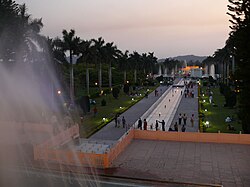Pinjore Baisakhi Festival
Pinjore Baisakhi Festival, a two-day spring festival of Vaisakhi is usually held in April of every year, with regional gourmet food, traditional handlooms and handicrafts, live folk arts and cultural performances, specially by the Haryana State Department of Information, Public Relations & Cultural Affairs at 6 pm.
Pinjore Mango Fair
Pinjore Mango Festival, a two-days summer mango fair held every second weekend of July since 1992 by Haryana Tourism and Department of Horticulture, Haryana, at the historical Mughal Gardens at Pinjore to celebrate and promote India's status as world's largest producer of the king of fruits mango by encouraging farmers to adopt technology for increasing production and quality. Hundreds of appetising varieties of mangoes from as far as Maharasthra, Bihar, Uttar Pradesh and also from Haryana, Himachal and Punjab arrive here, delighting everyone with their fragrance, taste, hybrid shapes and quality. The festival entails mangoes competition, carts competition for school students, cultural programmes, crafts bazar, food court and evening cultural performances. Government of Haryana decided to upgrade the festival to an international festival from 2018 onward, by inviting competitive entries, exhibitions and cultural performances from all other nations.
Nearly 4,000 entries are received for the competition across different categories of mango, including nearly 3,500 entries for various species of mango and nearly 500 entries of mango products such as pickle, chutney, jam, pulp, juice, squash and mango leather. These entries are judged by the expert scientists from Chaudhary Charan Singh Haryana Agricultural University (Hisar), Maharana Pratap Horticultural University, Karnal, [5] Punjab Agricultural University (Ludhiana), and Indian Agricultural Research Institute (Modipuram, UP). The popular varieties in the competition are Alphonso, Amrapali, Chaunsa, Dasheri, Langra, Malda, Malika, Ramkela pickle variety, Ratol, Totapuri and many more. haryana Kesari (for entries from Haryana), Hind Kesari (for entries from other parts of India) and Aam Kesari (for entries any part of the world) titles are awarded with winners shield and certificate.
A splash of festivities and colours of Harynavi cultural extravaganza make this event far more popular, this attracting mango enthusiasts from all spheres of life. During the day students from different schools perform various competitive cultural programs, such as dance, music, rangoli, etc. In the evening, artistes from the North Zone Cultural Centre present a colourful cultural programme of folk songs and dances, such as Haryanvi music and dance, Punjabi music, Folk dances of Punjab, Himachali folk dances and Indian classical dance.
Pinjore Heritage Festival
Pinjore Heritage Festival, a two-day winter festival held every year in the last week of December, showcases exquisite cultural heritage of the state and region with cultural performances, dance and music competitions, craft bazar, food court and evening performances. The garden is decorated with lights, cutouts, platforms, decorated gates and illuminations.







